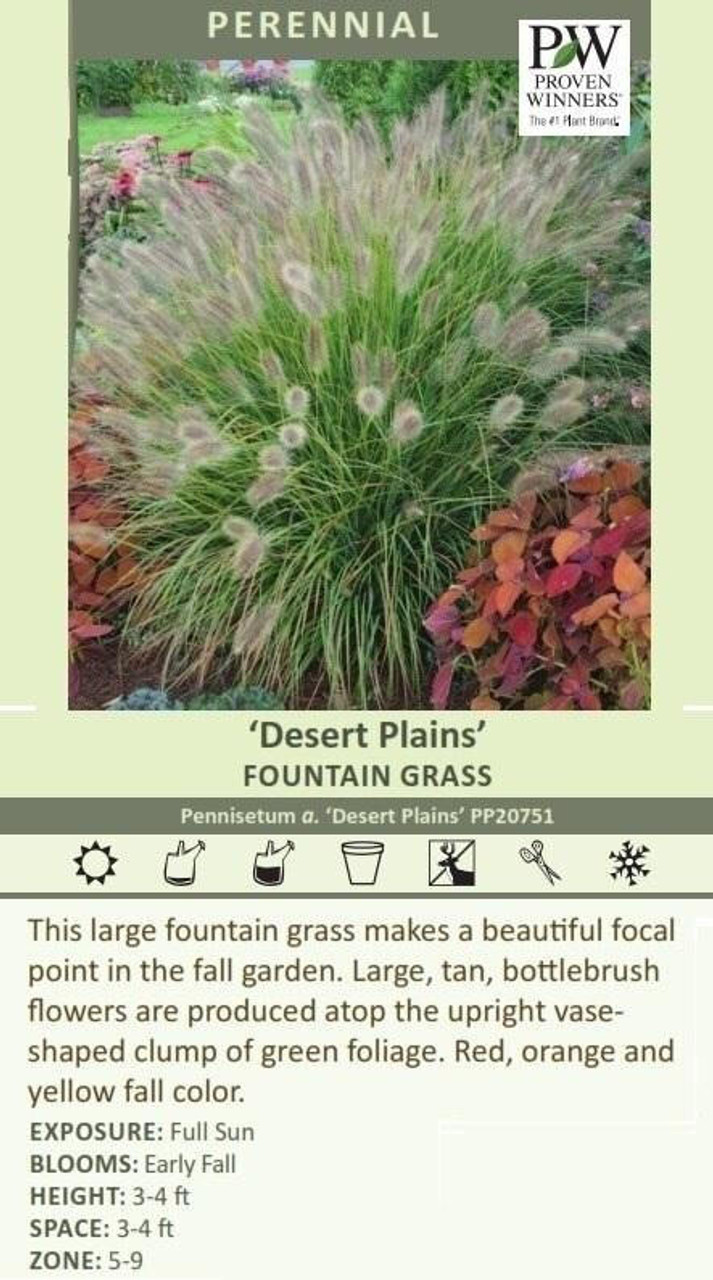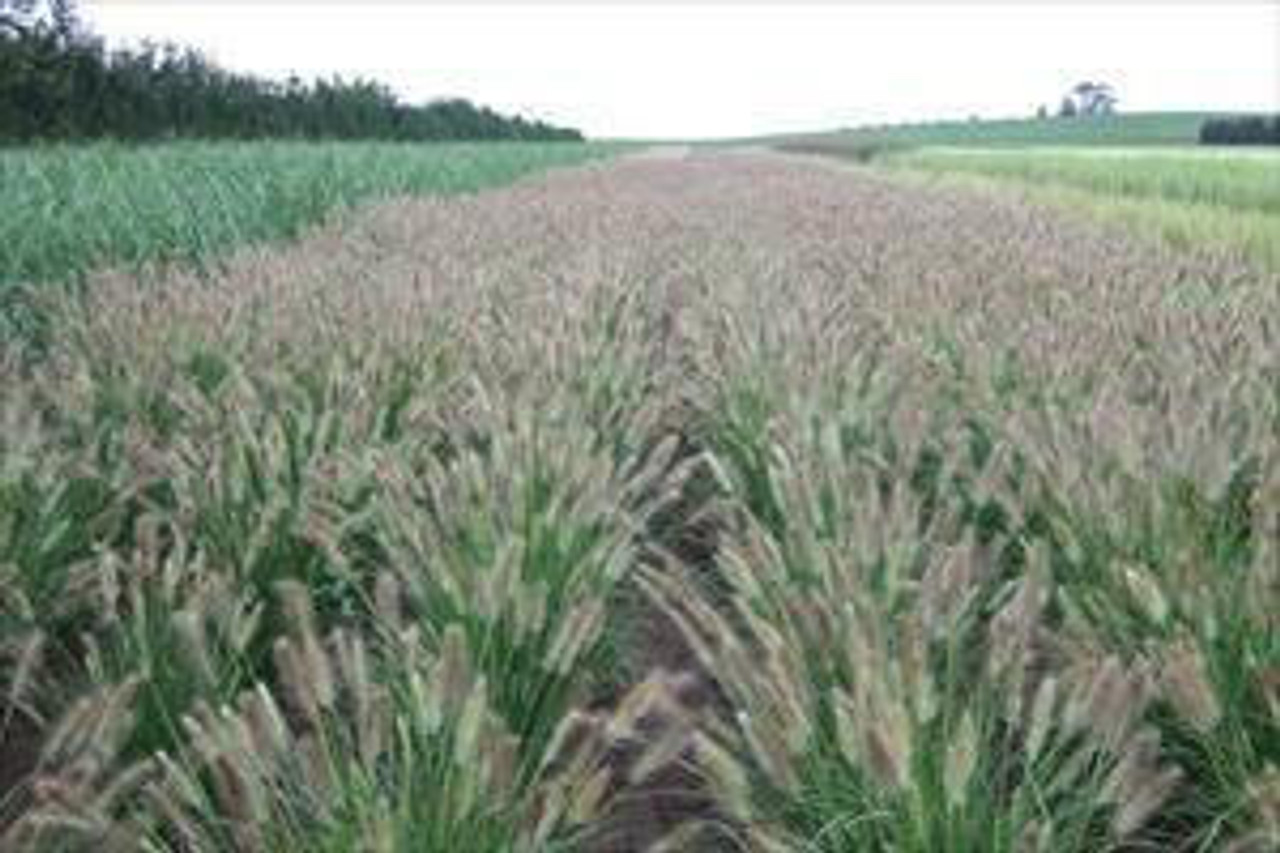Product Description
Pennisetum alopecuroides 'Desert Plains' PP20751 (4) 1-gallons
Common Name: Grass-Ornamental, Fountain Grass
Zone 5 to 9, Full sun
Plants reach 4 feet tall and 3 to 4 feet wide.
This large fountain makes a great focal point in a sunny landscape. It is easy to grow as long as full sun is provided. Many consider it to be the best hardy Pennisetum available today. 'Desert Plains', a seedling of 'Cassian', has an improved habit and flowering performance over 'Cassian'.
- Superior vase-like habit, fall color, and improved flowering performance over older cultivars
- Narrow green leaves turn red, orange, and gold in fall
- Showy, large 5-inch bottlebrush flowers
Pennisetum alopecuroides 'Desert Plains' is a standout ornamental grass known for its impressive size, attractive foliage, and showy flower plumes. It is a great choice for adding texture, movement, and a touch of drama to sunny gardens. Here is a closer look at what makes this cultivar special:
- Upright Vase Shape: 'Desert Plains' forms a dense, upright clump of gracefully arching, linear leaves that create a beautiful vase-like shape. This adds a strong vertical element to the garden and makes it a great focal point.
- Foliage Color Changes: The foliage starts bright green in summer, then the tips begin to turn a deep red as the season progresses. In fall, the entire clump transitions to warm shades of orange and gold, providing multi-seasonal interest.
- Showy Flower Plumes: In mid to late summer, large, smoky purple, bottlebrush-like flower plumes emerge above the foliage. These plumes resemble foxtails and add a touch of whimsy to the garden. They mature to a tan color and look particularly stunning when backlit by the sun.
- Adaptable and Hardy: 'Desert Plains' thrives in full sun and prefers well-drained soil. It is drought-tolerant once established and hardy in USDA zones 5-9, making it suitable for various climates.
- Low Maintenance: This ornamental grass is relatively low-maintenance and does not require deadheading or frequent watering.
- Wildlife-Friendly: The flowers attract birds and other wildlife, and the dense foliage provides shelter for small creatures.
Growing Tips:
- Sunlight: Plant in full sun (at least 6 hours per day) for the best foliage color and flowering. It can tolerate some light shade, but the flower production may be reduced.
- Soil: Prefers well-drained soil but tolerates a variety of soil types, including moist but well-drained soils.
- Water: Water regularly during the first growing season to establish a strong root system. Once established, it is fairly drought-tolerant.
- Hardiness: 'Desert Plains' is hardy in USDA zones 5-9, tolerating cold winters and hot summers.
- Maintenance: Cut back the foliage to the ground in late winter or early spring before new growth emerges. This will tidy up the plant and encourage fresh growth.
Design Ideas:
- Specimen Plant: Its impressive size and attractive form make it a great choice as a specimen plant in a sunny border.
- Mass Plantings: Create a dramatic effect by planting 'Desert Plains' en masse, forming a sea of colorful foliage and plumes.
- Borders: Use it in borders to add height, texture, and contrast with other perennials.
- Containers: Its manageable size makes it suitable for container gardening, adding a vertical accent to patios and decks.
- Meadow Gardens: Combine with other native wildflowers and grasses for a naturalized look.
- Erosion Control: Its dense root system makes it a good choice for stabilizing slopes and preventing erosion.
(4) 1-gallon containers ready to plant, plants may be trimmed for shipping,
Other Details
The most important part of the plant is its root system. Healthy roots are the foundation of a healthy, vibrant plant. The type of plug container used is based on the specific needs of the plants. Perennials offered as bare root traditionally perform better when planted as bare root.Planted in a specialized mix, potted plants have well established root systems. Top growth stage will vary depending on the current life cycle and time of year when shipped. In Winter and early Spring dormant plants may be shipped. Dormant plants may be planted right away, even before the last frost date.
Most bare root varieties are field grown for at least one season, though Hemerocallis and Hosta are grown for two seasons. The bulk of the soil is removed during the harvesting process and the tops of most varieties are trimmed back to the crown. They are graded, packed in shredded aspen or sphagnum moss and stored in freezers until ready to be shipped.
See our Container Sizes and Bare Root Perennials pages for more information.
Plant information and care is provided in the Overview section, Plant Genus Page and general information is provided in the Planting Care & Guides. Additional questions can be asked on each Plant page.
Plant Spacing: Using the maximum mature spread or width of a plant to guide spacing, ensures space to grow to full size. To fill an area sooner, plant them closer together. Just remember, future thinning or transplanting may be needed.
Water: Keep a close eye on newly planted perennials, especially throughout the first growing year. Most early plant loss is due to too much or too little water!














